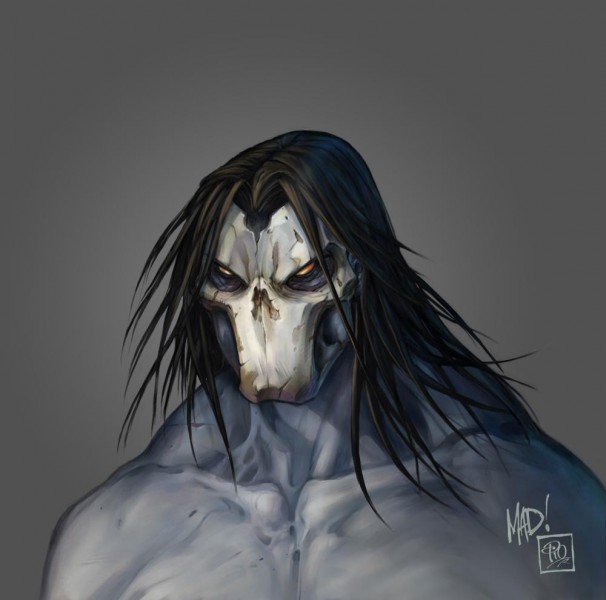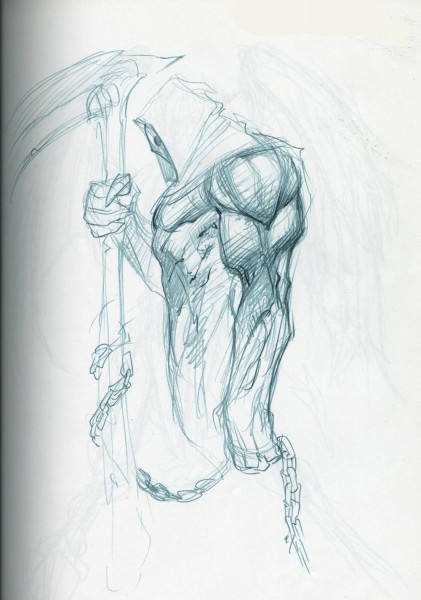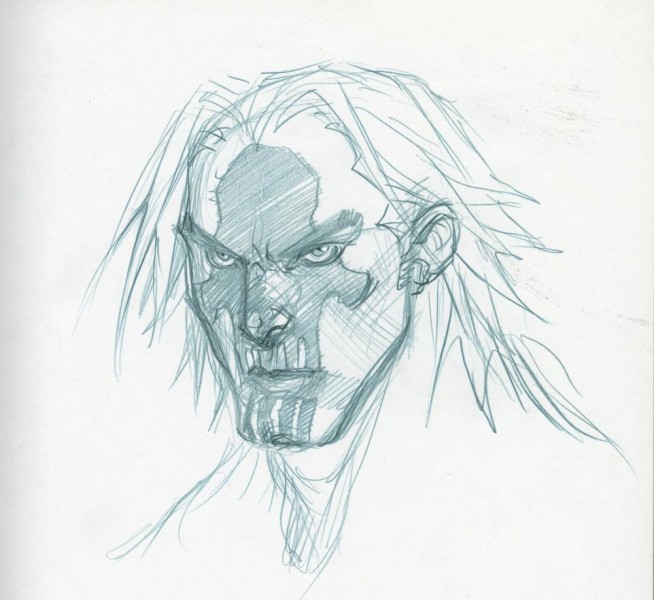Darksiders II: The Evolution Of Death

Darksiders II is breaking what some would consider rule number one for video game sequels: Never change the main character. Not satisfied to send gamers on another adventure as the hulking War from the first game, Joe Madureira and the team at Vigil instead went back to the early concepts they had sketched out for the other three Horsemen of the Apocalypse to find a new lead character. During our recent trip to Vigil, we talked to Madureira about the process of creating this new character and dug up some old sketches of the character.
“The earliest vision for Darksiders was to play the four horsemen cooperatively, so for our pitch and prototype, I had already loosely concepted all four of them,” Madureira explains. “We knew roughly what playstyle and what personality they would have at that time, since we were planning to do all four.” Digging into those early pieces, one character stood out as someone who would give the sequel a truly unique feel from the original: Death.

“We wanted to get basically as far away from War as you can,” Madureira says. “War was a very stoic, slow-moving, hulking, massive warrior. We gave Death movements more like an assassin or a rogue. He’s very agile, very quick, very aggressive, whereas War was a little more reactive.” Madureira’s excitement is evident in his voice as he describes the dark new hero: “I like those kinds of characters, so it’s perfect.”
This focus on faster movement affects every level of the character design, right down to what he wears: “If his armor gets too heavy, obviously he starts to get into War’s territory.” This became an even greater concern as Madureira realized that loot was going to become a major gameplay element for the sequel. “Not only do the pieces need to look good as a whole set, but you might equip shoulders from one set and the chest from another set with the boots from another set,” he laments. “It could look ridiculous, so we have to test each and every piece against itself so that hopefully it looks cool no matter what combination.”
From an art design standpoint, Madureira describes the loot system as “limiting” but “a lot more rewarding.” This is especially true for the players: “Changing something on your character every 10 or 15 minutes that you’re playing is pretty exciting.”
As Madureira set out to work on a final design for Death, Vigil decided they wanted to focus on the supernatural elements in series in general and the character specifically. “We wanted to play up the dead aspect of him and make him look almost zombie-like,” Madureira says. “He’s as close to a zombie as you’d want to get for the main character of a game.”


Early into the design process on Darksiders II, Madureira toyed with some very strange iterations of the Death concept. “Early on I had played with the idea of giving him six arms and a weapon in each hand [pictured above],” Madureira laughs. “It was really impractical stuff that we knew we really wouldn’t do…. Any time we started to mess around and experiment with Death’s design, we never liked it as much as what we already had, so we just kind of stopped.”
One element of Death’s design that did change was his weapon. Some of Madureira’s original sketches feature the character equipped with a more traditional large scythe, but that changed as Vigil began work on Darksiders II. “There was already a competing product that has a scythe-wielding character,” Madureira says, referencing EA’s 2010 release Dante’s Inferno, “so right off the bat, that wasn’t that appealing to us. And because it’s a really large weapon, it would be wielded more slowly. That didn’t fit in with Death’s more aggressive, feral nature. Splitting it into two smaller scythes and dual-wielding seemed ten times more bada**.”
Vigil also decided to shift Death’s personality. Originally intended to be “more of a haunting figure that never spoke,” Madureira explains that this would not have set the character apart from War well enough: “We didn’t push War as far as we could as a character. He didn’t talk a lot. So we felt like if Death didn’t speak at all, that would be harder, so we decided to change that up and make him more intelligent and chatty. He has a dry sense of humor.”

One of the challenges of making Death a more interesting personality was figuring out how to show emotion on a character without a visible face. Some early sketches featured Death without his mask (like the one above), but in the end, Vigil stuck with the iconic masked version and searched for other ways to make him expressive.
“We were worried we wouldn’t be able to convey expression, and the dialogue would fall flat,” says Madureira. “So I did a sheet of how his mask and eyes could convey most of the emotion [pictured below]. Obviously he has to act with his body a little bit more. We’ve done enough tests with the cutscenes that we feel comfortable that having a guy with no face is going to work.”

In the end, Madureira believes going with the masked version of Death was the right choice, as it has actually become a defining visual characteristic for the horseman. “If we put a helmet on Death or we changed his mask or we hid his hair, he would look like a different character. There are certain things about Death that we will not change,” Joe promises. “That’s why we don’t have helmets in the game. He’ll only ever be lightly armored. No matter what armor you equip, it’s still Death, but if we were to cover him up completely in chainmail in big shoulder pads, you’d wonder who it is.”
With what Madureira describes as “the iconic necromancer/zombie look” for Death, he’s hopeful that gamers will quickly become accustomed to the new character and never have to wonder who he is.
Remember to check out our Darksiders II hub for more Darksiders II content.











